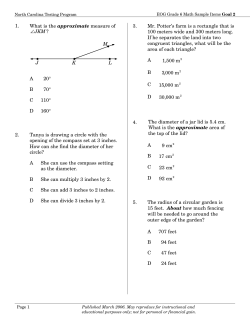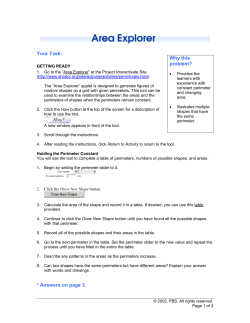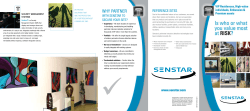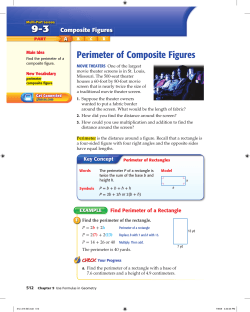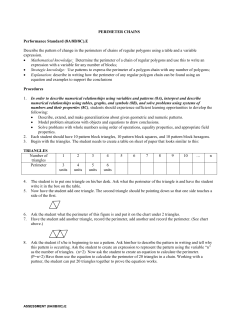
TEACHER WORK SAMPLE 1 An Example of a Teacher Work Sample:
TEACHER WORK SAMPLE 1 An Example of a Teacher Work Sample: A Unit on Perimeter and Area for 6th Grade Advanced Math Matthew R. Lavery University of Central Florida TEACHER WORK SAMPLE 2 An Example of a Teacher Work Sample: A Unit on Perimeter and Area for 6th Grade Advanced Math Contextual Factors This unit was developed for a sixth grade Advanced Math class on block scheduling at a large, diverse middle school in central Florida. The curriculum for the Advanced Math course is designed for students that perform at or above grade level in math. This school also offers sixth grade Honors Pre-Algebra I, the first half of a two-year program designed to prepare students to take Algebra I in the eighth grade. Most students that are high-achieving in math (i.e., that score a 5 or a high 4) are placed in this other course. Thus, the Advanced Math courses contain students who scored at achievement levels 3 and 4 on the fifth grade math FCAT. My supervising teacher teaches three Advanced Math sections, one section of Honors Pre-Algebra I, and two remedial math classes for students who have not passed the FCAT. This TWS will include the unit on perimeter and area that I prepared for the three Advanced Math classes. The school serves about 1400 students from a diverse metropolitan area. 51.7% of the students at the school identify themselves as Hispanic, 27.4% as White, Non-Hispanic, 12.1% as Black, Non-Hispanic, 2.8% as Asian or Pacific Islander, 0.4% as Native American, and 5.6% as multiracial. At this school, 20.8% of the students are identified as ELLs, 13.6% of the students receive ESE services for a disability, and 67.9% of the students qualify for free or reduced price lunch. My classes are very similar to the demographics of the school. Based on the data available to the teacher through the grade book system, of the 65 students in these three classes, 32 are identified as Hispanic, 19 as White or Caucasian, 10 as Black or African-American, and 4 TEACHER WORK SAMPLE 3 as Asian. Nine of these students are identified as ELLs currently receiving ESOL services, while 4 students receive ESE services, and one is in tier three of the Response to Intervention (RtI) process. The ELLs in these classes all function at intermediate or advanced levels of English language proficiency. Spanish is the first language for 6 of these ELLs, while two students were raised speaking Haitian Creole, and one student originally spoke Vietnamese. The IEPs of the four students receiving ESE services indicate the nature of their disabilities. Three students have language-related specific learning disabilities that hinder their reading comprehension and writing abilities. One has a mild Autism Spectrum Disorder (ASD) that affects his interaction with others and may cause him to feel overwhelmed and overstimulated in noisy or chaotic situations. The student in RtI is under evaluation for a suspected emotional behavioral disorder. Learning Goals The goals for this unit are based on the Sunshine State Standards for sixth grade that relate to perimeter and area. All of the students in these classes performed at or above grade level on last year’s FCAT, so these standards should be appropriate for this group of students. Since the FCAT typically uses word problems, I will also use word problems in my classroom activities and assessments. In order to support the ELLs in the class, I will include clearly labeled visual aids or diagrams for each word problem. I may also have to support the students with language impairments and teach them specific strategies to deal with the word problems. TEACHER WORK SAMPLE 4 The specific learning goals for this unit are as follows: 1. The student will understand the concept of π, know common estimates of π (3.14 and 22/7) and use these values to estimate and calculate the circumference and the area of circles (Sunshine State Standards: MA.6.G.4.1). 2. The student will find the perimeters and areas of composite two-dimensional figures, including non-rectangular (such as semicircular) parts (Sunshine State Standards: MA.6.G.4.2). 3. The student will determine a missing dimension of a plane figure given its area and some of the dimensions (Sunshine State Standards: MA.6.G.4.3). Assessment Plan My supervising teacher uses mini quizzes, with three or four questions, about once per week to assess the students on material they have studied recently and as part of their final grade. I will continue to use this system, since these students are accustomed to it, but I will also use informal questioning and some of the unit’s learning activities to help me assess the students’ understanding of the material. Class Meetings: Week before unit Description of Assessment: Pretest (included at end of TWS) Learning Goals Assessed: 1, 2, 3 Day 2 Finding Pi activity 1 Day 3 Mini Quiz 1 (simple figures) 1, 2 Day 4 Campus Geometry 1, 2 Day 5 Mini Quiz 2 (composite figures & missing dimensions) 2, 3 Day 5 Perimeter & Area Unit Practice 1, 2, 3 Day 6 Posttest (included at end of TWS) 1, 2, 3 TEACHER WORK SAMPLE 5 Design for Instruction The pretest showed me that these students know how to find the perimeter and area of simple shapes when the information that they need is given to them very simply. Students did very well with the questions that had a diagram of a simple shape and asked them for the perimeter or area. Each class scored over 80% on these kinds of questions. Students had a much tougher time applying these skills in more complex problems. If the question used a complex shape, if they needed to use multiple steps and formulas, or if the information they needed was in a word problem, students were much more likely to get it wrong. These results told me that I didn’t need to spend too much time teaching them what perimeter and area are, but that I really needed to teach them how to use that knowledge in more complex ways. I also need to teach these students how to approach word problems better. I always planned to use the first day to introduce vocabulary, formulas, and practice some simple problems. After seeing my pretest results, though, I think will spend more time on all the different ways that perimeter and area can be described in word problems. I’ll also spend some time teaching students specific strategies for chopping up composite shapes into more manageable pieces. The unit will follow the general timeline below. For more detail, I have attached my lesson plans (NOTE: This example of a TWS does not include detailed lesson plans). Day 1: Unit Introduction – vocabulary, formulas, & word problem strategies Day 2: Finding and Applying Pi – an activity calculating pi in small groups by wrapping string around cylindrical objects to measure their circumference, and TEACHER WORK SAMPLE 6 another activity cutting up construction paper circles and arranging the pieces in a parallelogram to find its area Day 3: Mini Quiz 1, Composite Shapes, & Missing Measures – strategies and practice breaking complex, composite shapes into smaller ones to find perimeter and area, and using formulas in reverse to find missing measurements Day 4: Campus Geometry – activity with a partner using meter sticks to measure designated parts of the campus or the school building Day 5: Mini Quiz 2 and Unit Review and Practice – review and individual practice on all learning goals and concepts Day 6: Unit Posttest Instructional Decision Making Example One: The first example of a time that I had to adjust my instructional plan came when I had the students do the Applying Pi activity. When I did this exercises with my first block class, the students seemed to have a really hard time with the instructions. When I asked them to cut up the construction paper circles and arrange them with the points of each wedge in alternating directions to make something that looks sort of like a parallelogram, they were clearly confused. The written directions had a few drawings that I thought were pretty clear, but they were not as clear as I had hoped. During first block, several groups of students seemed confused and started to get frustrated. The ELLs in this class especially seemed to have difficulty with the written directions, even though the EELs were in groups with native English speakers as well. It seemed that the students’ confusion and frustration started to get them agitated. I feared that the noise level and chaos may start to over stimulate and overwhelm the student with ASD. TEACHER WORK SAMPLE 7 I stopped the class as soon as I realized the confusion so that I could demonstrate the activity and clarify the directions. As I showed them what they needed to do step by step, I began to hear students saying things like, “Ooohh,” and “I get it.” During the planning period that comes right after this class, I added some additional slides to my instructions that I use at the beginning of class, and pre-cut a series of construction paper circles to illustrate each step. This made the instructions much more clear for my third and fourth block classes, and helped the students get more out of the activity. Because the instructions were better, the students needed less time to complete the activities. This left more time for us to compare everyone’s results and process through the activity to help build their understanding of using π to find a circle’s perimeter and area. Example Two: The second time that I needed to adjust my plan came when I taught the students how to find the missing dimensions of a shape given its perimeter or area, and some of the other dimensions. My supervising teacher told me to think of each block as two class periods that happen back to back. I followed this advice, and planned to use day 3 to teach two lessons; one on finding the perimeter and area of composite shapes, and the other on finding the missing dimensions of a shape when given some of its dimensions and the area or perimeter. Each lesson was supposed to have a short assignment that the students would begin to work on in class and finish for homework. I used the time while students worked on the practice exercises in class to circulate around the room and check their understanding of each concept. The students seemed to understand the lesson on composite shapes well, and their performance on the practice exercises confirmed that. Unfortunately, the students seemed to have a great deal of difficulty with the Missing Measures practice exercises. The problem seemed to TEACHER WORK SAMPLE 8 come from the algebraic thinking required for students to use the formula for the perimeter and area to find one of the other values. It wasn’t natural for them to “use the formula backwards” like I suggested. They also seemed to have a hard time using division to reverse multiplication, and using subtraction to reverse addition. The practice exercises confirmed that they were having a hard time with it. As I discussed the lesson with my supervising teacher later that day, I suggested that I should delay the unit review and posttest, and include another lesson that focuses on the algebraic thinking required to solve these kinds of problems. She agreed. I planned a lesson for the first part of the block that taught students how to reverse mathematical operations, and a lesson for the second part of the block that applied those skills more naturally to the kinds of problems that go with Learning Goal 3. This was the reinforcement that many of these students needed, and the students did much better with the Missing Measures exercises after that. Analysis of Student Learning The pretest and posttest results definitely show that my students increased their understanding of perimeter and area. The graphs on the next pages show the individual student scores on the pretest and posttest for each student in the three classes in which I taught this unit. It is clear from these graphs that every student improved during the unit, resulting in a higher score on the posttest than the pretest. Students gained anywhere from 13 to 60 percentage points on their test scores over the course of the unit. Generally, the students with the lowest pretest scores had the greatest gains. This makes sense, since those students had the most room to grow. These results show me that my instruction was not over their heads, but appropriate for my students’ abilities and educational needs. PreTest% PostTest% 10.0% 0.0% B1S22 B1S16 B1S12 B1S01 B1S18 B1S07 B1S10 B1S19 B1S08 B1S04 B1S09 B1S14 B1S21 B1S02 B1S13 B1S20 B1S06 20.0% B3S21 30.0% B1S03 40.0% B3S20 50.0% B1S17 60.0% B3S19 70.0% B1S15 80.0% B3S18 90.0% B1S05 100.0% B3S17 Block 3 Learning Gains B1S11 PostTest% B3S16 B3S15 B3S14 B3S13 PreTest% B3S12 B3S11 B3S10 B3S09 B3S08 B3S07 B3S06 B3S05 B3S04 B3S03 B3S02 B3S01 TEACHER WORK SAMPLE 9 Block 1 Learning Gains 100.0% 90.0% 80.0% 70.0% 60.0% 50.0% 40.0% 30.0% 20.0% 10.0% 0.0% TEACHER WORK SAMPLE 10 Block 4 Learning Gains 100.0% 90.0% 80.0% 70.0% 60.0% 50.0% 40.0% 30.0% 20.0% 10.0% PreTest% B4S14 B4S20 B4S19 B4S07 B4S06 B4S04 B4S02 B4S17 B4S08 B4S01 B4S16 B4S12 B4S15 B4S21 B4S10 B4S18 B4S05 B4S03 B4S22 B4S11 B4S13 B4S09 0.0% PostTest% The average score on the pretest was a failing grade, and showed that the students were not ready to be tested on these learning goals the way that the FCAT will probably test them in sixth grade. The average grade on the posttest was a solid B. This showed that, overall, I was able to help my students gain sufficient mastery of these learning goals. In fact, before I taught this unit, the highest grade on the pretest was an 80%, the lowest possible B, and more than half of the students failed. Of the 65 students that took the posttest after I taught this unit, 52 of theme scored a B or higher, and only 2 failed. One of these 2 students was an ELL that was very resistant to instruction throughout the class and did not complete most of her assignments. I attempted several times to determine what the problem might be and offer my support. She did not respond to my efforts. The other student that failed was the student in RtI for a suspected Emotional Behavioral Disability. This student TEACHER WORK SAMPLE 11 seemed to do well throughout the entire unit. He seemed to understand the instruction and did well on his assignments. Unfortunately, on the day of the posttest, he was upset because of an incident in a previous class and was not interested in doing careful work. He may have shown more improvement if he was allowed to take the test at a later date. I also analyzed the students’ pretest and posttest averages by their student group, such as ELLs, ESE students, and regular education students. This showed that my students in ESE made the most improvement, while my ELLs showed the least improvement. Overall, every group made gains and each group’s average score was a C or better on the posttest. Evaluation and Reflection Overall, I think the unit was a success. I think it was important that I decided to use word problems like the FCAT uses that require multiple steps to find the answer. It required more work for me, but I think it made a difference in student learning. I think one of the reasons the pretest scores were so low is because my students haven’t been asked many complex, multi-step problems in their math classes before. I did use a few practice exercises from the book as we learned individual skills in each lesson. By keeping my focus on the ultimate goal of complex, multi-step word problems, though, I didn’t decide that the students had “gotten it” until I had them show me that kind of mastery. I did have to break down these kinds of problems into smaller steps and teach my students how to analyze them, but I think the kind of test that I used and the results that my students got on them shows that it worked. My best learning goal was learning goal 3. Even though the students scored a higher average on posttest questions related to learning goal 2, my students showed the greatest TEACHER WORK SAMPLE 12 improvement on learning goal 3. My students told me that they haven’t been asked to use the area or perimeter to find the length of one of the sides of a shape before. According to my supervising teacher, the sixth grade students at this school are generally weak in algebraic thinking, too. This means that much of what I taught them for learning goal 3 was a new way to think about math and geometry. That’s probably why I had to go back and reteach this topic in a different way and spend more time on this goal than I did on the others. It seems to have paid off, though, since the students seem much more comfortable with these kinds of questions now than they were the first time they saw them. My students showed the least improvement on learning goal 2. Even though the students had the highest average scores on pretest questions for this learning goal, half of the questions simply had a shape with its dimensions labeled, and asked them for the perimeter or area. These kinds of questions are just like questions that they have seen before. The students had a much tougher time with word problems that used composite shapes. When they had to decode the word problem and perform multiple steps, like using formulas to find multiple areas and then adding or subtracting them to find the final answer, they had a much tougher time. To get better at these kinds of problems, I had to teach them how to analyze the word problem to understand what it was asking, and I had to teach them how to properly work with complex composite shapes to correctly find their perimeter or area. As I graded the posttests, it seemed like some students got better at analyzing the word problems, and other students got better at dealing with composite shapes, but few students got better at both. I probably could have spent a little more time on this learning goal, too, and gotten much better results. TEACHER WORK SAMPLE 13 This work sample showed me that I am already pretty good at accommodating for students’ individual needs. The improvement shown by the ESE students in my classes supports this. Clearly, I need to spend some time learning new, specific interventions to support ELLs, as this was my weakest group. I try to check for understanding with each individual student and work with them in whatever way they need to help them learn the material. Perhaps, with additional strategies and practice supporting ELLs, I will see the same kind of dramatic growth with them as my students with disabilities. TEACHER WORK SAMPLE NOTE: This example of a TWS only includes the first page of the pretest and posttest. 14 TEACHER WORK SAMPLE NOTE: This example of a TWS only includes the first page of the pretest and posttest. 15
© Copyright 2025


